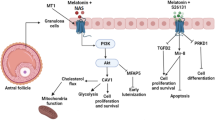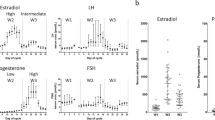Abstract
Epidemiological data have implicated the pituitary gonadotropin follicle stimulating hormone (FSH) as both a risk factor for and a protective agent against epithelial ovarian cancer. Yet, little is known about how this hormone could play such opposing roles in ovarian carcinogenesis. Complementary DNA microarrays containing 2400 named genes were used to examine FSH-induced gene expression changes in ovarian cancer (OC) and immortalized normal human ovarian surface epithelial (HOSE) cell lines. Two-way t-statistics analyses of array data identified two distinct sets of FSH-regulated genes in HOSE and in established OC cell lines established from patients (OVCA cell lines). Among the HOSE cell lines, FSH increased expression of 57% of the 312 genes and downregulated 43%. In contrast, FSH diminished expression of 92% of the 177 genes in the OVCA cell lines. All but 18 of the genes affected by FSH in HOSE cell lines were different from those altered in OVCA cell lines. Among the 18 overlapping genes, nine genes exhibited the same direction of change following FSH challenge, while the other nine showed discordance in response between HOSE and OVCA cell lines. The FSH-induced differential expression of seven out of nine genes was confirmed by real-time RT–PCR. Gene-specific antisense oligonuleotides (ODNs) were used to inhibit the expression of genes encoding GTPase activating protein (rap1GAP), neogenin, and restin in HOSE and OVCA cells. Antisense ODNs to neogenin and restin, but not an antisense ODN to rap1GAP, were effective in inhibiting OVCA cell growth, diminishing proliferating cell nuclear antigen expression, and increasing caspase 3 activities. Furthermore, the ODN to rap1GAP was further shown to be ineffective in altering migration properties of OVCA cell lines. HOSE cell proliferation was not affected by treatment with any of the antisense ODNs. In summary, gene profiling data reveal for the first time that FSH may exert different biological actions on OVCA cells than on HOSE cells, by differential regulation of a set of putative oncogenes/tumor suppressors. Specifically, neogenin and restin were found to exhibit proproliferation/survival action on OC cells.
This is a preview of subscription content, access via your institution
Access options
Subscribe to this journal
Receive 50 print issues and online access
$259.00 per year
only $5.18 per issue
Buy this article
- Purchase on Springer Link
- Instant access to full article PDF
Prices may be subject to local taxes which are calculated during checkout






Similar content being viewed by others
References
Ala-Fossi, SL, Grenman S, Zhang FP, Blaue, M, Punnonen R and Maenpaa J . (1999). Anticancer Res., 19, 4289–4295.
Altschuler DL, Peterson SN, Ostrowski MC and Lapetina EG . (1995). J. Biol. Chem., 270, 10373–10376.
Auersperg N, Wong AS, Choi KC, Kang SK and Leung PC . (2001). Endocr. Rev., 22, 255–288.
Bast RC Jr, Feene, M, Lazarus H, Nadler LM, Colvin RB and Knapp RC . (1981). J. Clin. Invest., 68, 1331–1337.
Bilbe G, Delabie J, Bruggen J, Richener H, Asselbergs FA, Cerletti N, Sorg C, Odink K . Tarcsay L, Wiesendanger W et al. (1992). EMBO J., 11, 2103–2113.
Callow ME, Callow JA, Ista LK, Coleman SE, Nolasco AC and Lopez GP . (2000). Appl. Environ. Microbiol., 66, 3249–3254.
Cao SX, Dhahbi JM, Mote PL and Spindler SR . (2001). Proc. Natl. Acad. Sci., 98, 10630–10635.
Cohen P . (1989). Annu. Rev. Biochem., 58, 453–508.
Conroy SE and Latchman DS . (1996). Br. J. Cancer, 74, 717–721.
Cramer DW, Liberman RF, Hornstein MD, McShane P, Powers D, Li EY and Barbieri R . (1998). Fertil. Steril., 70, 371–373.
Dujardin D, Wacke, UJ, Moreau A, Schroer TA, Rickard JE and DeMey JR . (1998). J. Cell. Biol., 141, 849–862.
Emons G, Ortmann O, Teichert HM, Fassl H, Lohrs U, Kullander S, Kauppila A, Ayalon D, Schally A and Oberheuser F . (1996). Cancer, 78, 1452–1460.
Erickson GF, Li D, Sadrkhanloo R, Liu XJ, Shimasaki S and Ling N . (1994). Endocrinology, 134, 1365–1372.
Feeley KM and Wells M . (2001). Histopathology, 38, 87–95.
Fuller-Pace FV . (1994). Trends Cell Biol., 4, 271–274.
Fuqua SA, Oesterreich S, Hilsenbeck SG, Von Hoff DD, Eckardt J and Osborne CK . (1994). Breast Cancer Res. Treat., 32, 67–71.
Gillett WR, Mitchell A and Hurst PR . (1999). Hum. Reprod., 6, 645–650.
Godwin AK, Testa JR and Hamilton TC . (1993). Cancer, 71, 530–536.
Halperin R, Hadas E, Langer R, Bukovsky I and Schneider D . (1999). Int. J. Gynecol. Cancer, 9, 502–507.
Hamilton TC . (1992). Curr. Probl. Cancer, 16, 1–57.
Heizisouer KJ, Alberg A, Gordan GB, Longcope C, Bush TL, Hoffman SC and Comstock GW . (1995). JAMA, 274, 1926–1930.
Hilliker C, Delabie J, Speleman F, Bilbe G, Bruggen J, Van Leuven F and Van den Berghe H . (1994). Cytogenet. Cell Genet., 65, 172–176.
Hofstra LS, Mourits MJ, de Vries EG, Mulder NH and Willemse PH . (1999). Anticancer Res., 19, 3627–3630.
Holschneider CH and Berek JS . (2000). Semin. Surg. Oncol., 19, 3–10.
Hough CD, Cho KR, Zonderman AB, Schwartz DR and Morin PJ . (2001). Cancer Res., 61, 3869–3876.
Ismail RS, Baldwin RL, Fang J, Browning D, Karlan BY, Gasson JC and Chang DD . (2000). Cancer Res., 60, 6744–6749.
Itoh K, Yoshioka K, Akedo H, Uehata M, Ishizaki T and Narumiya S . (1999). Nat. Med., 5, 221–225.
Ivarsson K, Sundfeldt K, Brannstrom M, Hellberg P and Janson PO . (2001). Hum. Reprod., 16, 18–23.
Konishi I, Kuroda H and Manda M . (1999). Oncology, 57, 45–48.
Lau KM, Mok SC and Ho SM (1999). Proc. Natl. Acad. Sci. USA, 96, 5722–5727.
Lee CK, Klopp RG, Weindruch R and Prolla TA . (1999). Science, 285, 1390–1393.
Lee HM, Greeley Jr GH and Englander EW . (2001). Mech. Ageing Dev., 122, 355–371.
Li M, Makkinje A and Damuni Z . (1996). J. Biol. Chem., 271, 11059–11062.
Mandai M, Konishi I, Kuroda H, Fukumoto M, Komatsu T, Yamamoto S, Nanbu K, Rao CV and Mori T . (1997). Eur. J. Cancer, 33, 1501–1507.
Marimoto RI, Tissieres A and Georgopoulos C . (1994.) The Biology of Heat Shock Proteins and Molecular Chaperones. Cold Spring Harbor Laboratory Press: Cold Spring Harbor, NY.
Markert JM, Fuller CM, Gillespie GY, Bubien JK, McLean LA, Hong RL, Lee K, Gullans SR, Mapstone TB and Benos DJ . (2001). Physiol. Genomics, 5, 21–33.
Mathew A, Mathur SK and Morimoto RI . (1998). Mol. Cell. Biol., 18, 5091–5098.
Meyerhardt JA, Look AT, Bigner SH and Fearon ER . (1997). Oncogene, 14, 1129–1136.
Mukherjee A, Urban J, Sassone-Corsi P and Mayo KE . (1998). Mol. Endocrinol. Endocrinol., 12, 785–800.
Oliver CJ and Shenolikar S . (1998). Front. Biosci., 3, 961–962.
Ono K, Tanaka T, Tsunoda T, Kitahara O, Kihara C, Okamoto A, Ochiai K, Takagi T and Nakamura Y . (2000). Cancer Res., 60, 5007–5011.
Parrott JA, Doraiswamy V, Kim G, Mosher R and Skinner MK . (2001). Mol. Cell Endocrinol., 172, 213–222.
Poerre P, Scheel J, Rickard JE and Kreis TE . (1992). Cell, 70, 887–900.
Rao BR and Slotman BJ . (1999). Endocr. Rev., 12, 14–26.
Rauh-Adelmann C, Lau KM, Sabeti N, Long JP, Mok SC and Ho SM . (2000). Mol. Carcin., 28, 236–246.
Rickard JE and Kreis TE (1996). Trends Cell Biol., 6, 178–183.
Risch HA . (1998). J. Natl. Cancer Inst., 90, 1774–1786.
Sassone-Corsi P . (1998). Int. J. Biochem. Cell Biol., 30, 27–38.
Schmid SR and Linder P . (1992). Mol. Microbiol., 6, 283–292.
Schummer M, Ng WV, Bumgarner RE, Nelson PS, Schummer B, Bednarsk, DW, Hassell L, Baldwin RL . Karlan BY and Hood L . (1999). Gene 238, 375–385.
Shridhar V, Lee J, Pandita A, Iturria S, Avula R, Staub J, Morrissey M, Calhoun E, Sen A, Kalli K, Keeney G, Roche P, Cliby W, Lu K, Schmandt R, Mills GB, Bast Jr RC, James CD, Couch FJ, Hartmann LC, Lillie J and Smith DI . (2001). Cancer Res., 61, 5895–5904.
Shushan A, Paltiel O, Iscovich J, Elchalal U, Peretz T and Schenker JG . (1996). Fertil. Steril., 65, 13–18.
Syed V, Ulinski G, Mok SC and Ho SM . (2002). J. Natl. Cancer Inst., 94, 617–629.
Syed V, Ulinski G, Mok SC, Yiu GK and Ho SM . (2001). Cancer Res., 61, 6768–6776.
Tsao SW, Mok SC, Fey E, Fletcher J, Muto MG, Knapp RC and Berkowitz RS . (1995). Exp. Cell. Res., 218, 499–507.
Tsukamoto N, Hattori M, Yang H, Bos JL and Minato N . (1999). J. Biol. Chem., 274, 18463–18469.
Venema J, Bousquet-Antonelli C, Gelugne JP, Caizergues-Ferrer M and Tollervey D . (1997). Mol. Cell. Biol., 17, 3398–3407.
Vielmetter J, Kayyem JF, Roman JM and Dreyer WJ . (1994). J. Cell. Biol., 127, 2009–2020.
Vossler MR, Yao H, York RD, Pan MG, Rim CS and Stork PJ . (1997). Cell, 89, 73–82.
Wang C, Kaufman JA, Sanchez-Ross MG and Johnson KM . (2000). J. Pharmacol. Exp. Ther., 294, 287–295.
Wang K, Gan L, Jeffery E, Gayle M, Gown AM, Skelly M, Nelson PS, Ng WV, Schummer M, Hood L and Mulligan J . (1999). Gene, 229, 101–108.
Wani MA, Denko NC and Stambrook PJ . (1997). Som. Cell. Mol. Genet., 23, 123–133.
Welsh JB, Zarrinkar PP, Sapinoso LM, Kern SG, Behling CA, Monk BJ, Lockhart DJ, Burger RA and Hampton GM . (2001). Proc. Natl. Acad. Sci. USA, 98, 1176–1181.
Wera S and Hemmings BA . (1994). Biochem. J., 311, 17–29.
Whittemore AS, Harris R and Itnyre J . (1992. Am. J. Epidemiol., 136, 1184–1203.
Yang YH, Dudoit S, Luu P, Lin DM, Peng V, Ngai J and Speed TP . (2000). Nucleic Acids Res., 30, e15.
Zheng W, Lu, JJ, Luo F, Zheng Y, Feng Yj, Felix JC, Lauchlan SC and Pike MC . (2000). Gynecol. Oncol., 76, 80–88.
Zheng W, Magid MS, Kramer EE and Chen YT . (1996). Am. J. Pathol., 148, 47–53.
Acknowledgements
We thank the editorial staff of Brigham and Women's Hospital, Harvard Medical School, Boston, for editorial help. This study was supported by NIH Grants CA091250 (to V. Syed) and CA94221 (to S-M Ho) and an Army Ovarian Cancer Research Program Grant DAMD17-99-1-9563 (to S-M Ho).
Author information
Authors and Affiliations
Corresponding author
Rights and permissions
About this article
Cite this article
Ho, SM., Lau, KM., Mok, Sh. et al. Profiling follicle stimulating hormone-induced gene expression changes in normal and malignant human ovarian surface epithelial cells. Oncogene 22, 4243–4256 (2003). https://doi.org/10.1038/sj.onc.1206437
Received:
Revised:
Accepted:
Published:
Issue Date:
DOI: https://doi.org/10.1038/sj.onc.1206437
Keywords
This article is cited by
-
Inhibitory effects of Rap1GAP overexpression on proliferation and migration of endothelial cells via ERK and Akt pathways
Journal of Huazhong University of Science and Technology [Medical Sciences] (2011)
-
Genomic analysis of epithelial ovarian cancer
Cell Research (2008)
-
Identification of ATF-3, caveolin-1, DLC-1, and NM23-H2 as putative antitumorigenic, progesterone-regulated genes for ovarian cancer cells by gene profiling
Oncogene (2005)
-
Are genetic determinants of asymmetric stem cell division active in hematopoietic stem cells?
Oncogene (2004)



